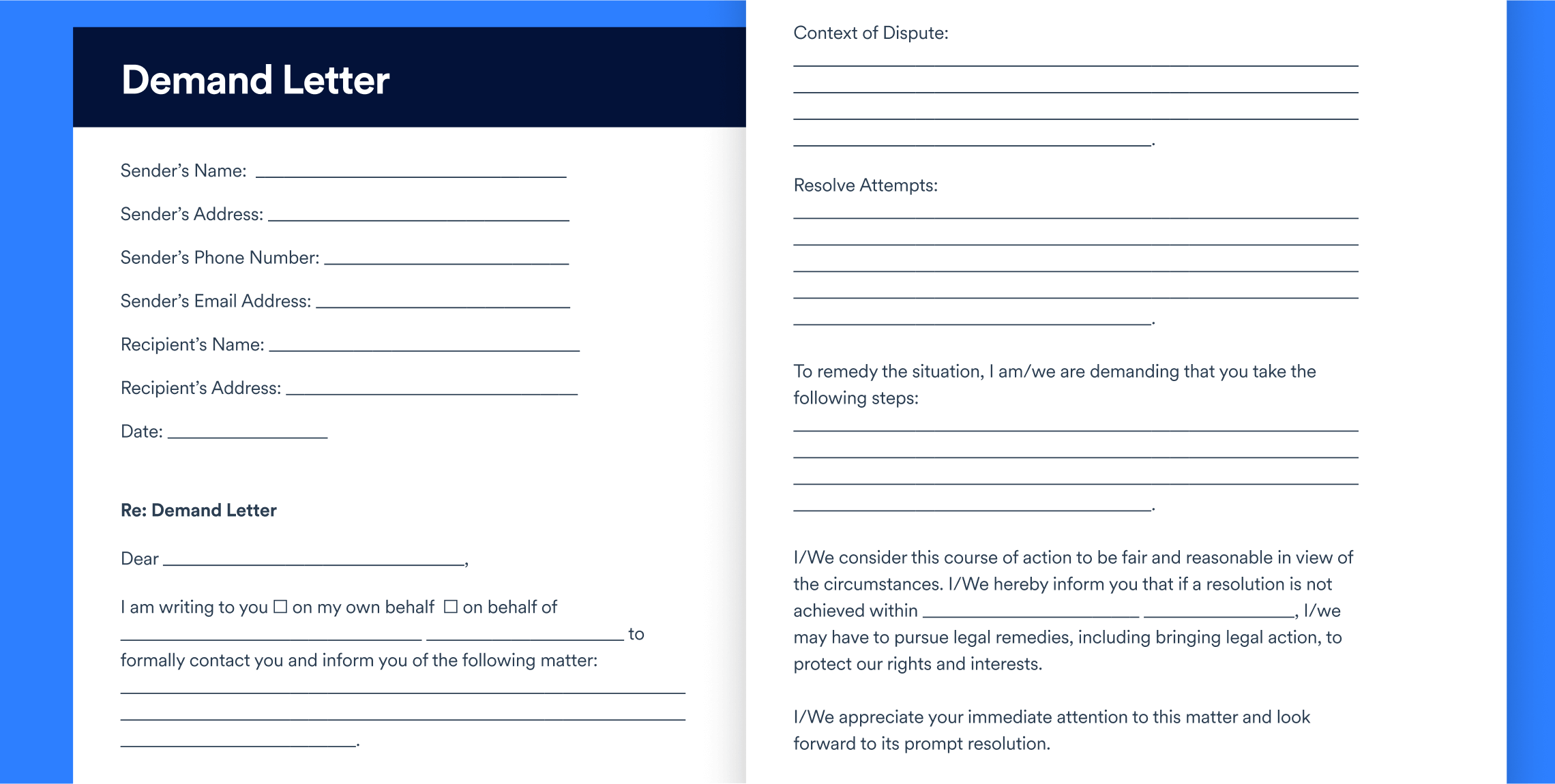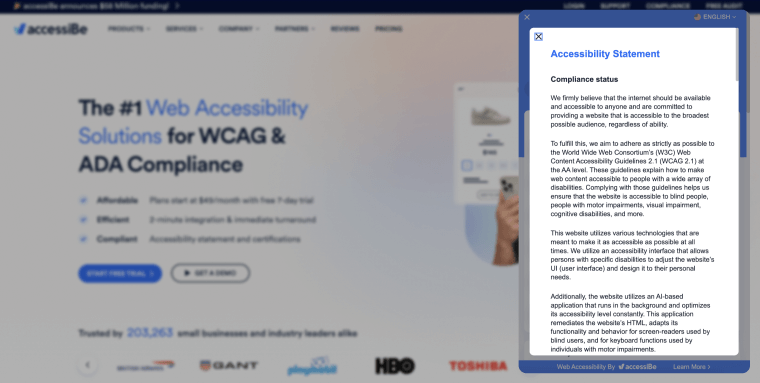The information presented within this guide is aimed at website owners seeking to learn the ropes of web accessibility. Technical elements are described in layman’s terms, and, as a rule, all topics pertaining to the legalities of web accessibility are presented in as simplified a manner as possible. This guide has no legal bearing, and cannot be relied on in the case of litigation.
For most businesses, having a website that complies with the Americans with Disabilities Act (ADA) is mandated by law. And, when a website is found to be in violation of the ADA, its owner can face legal recourse.
This includes receiving a demand letter.
Drawing your attention to areas of your website that are either completely or insufficiently accessible to people with disabilities, a demand letter will force you to take action.
But what should you do when you receive one? How do you properly address what appears in the letter and adjust your website so that it is accessible to all website visitors?
In this guide, we'll cover everything you need to know about ADA website compliance demand letters. We’ll explain what a demand letter is, who sends one, and what you, as a website owner, need to do if you are sent one.
Important note: accessiBe now offers litigation support to eligible customers, depending on their plan.
If you receive a demand letter after installing accessWidget (and if you have subscribed to a plan that includes our litigation support), our team will provide you with dedicated guidance, documentation, and a minimum $15,000 pledge to help you refute the claims with confidence.
What is ADA website compliance and what do demand letters have to do with it?
Under Title III of the ADA, businesses considered ’public accommodations’ must be accessible to people with disabilities. Given that all places of business provide services and accommodations to the public, this law applies to almost every business.
It is generally accepted that the ADA applies to businesses' websites, as well.
For a website to be considered ADA-compliant, it will need to meet web accessibility standards. The Department of Justice (DOJ) has frequently referenced the Web Content Accessibility Guidelines (WCAG) as the guidelines for web accessibility.
A significant number of U.S. court rulings have set an earlier iteration of these guidelines, WCAG 2.0 Level AA, as the goal for website accessibility. It is important to note, however, that this has not been codified into law. The updated version of these guidelines, WCAG 2.1, is currently the optimal measure of web accessibility when it comes to federal law.
WCAG 2.1 consists of three levels of conformance: Level A, Level AA, and Level AAA. We’ll explain the difference between them later in the blog.
If a website conforms to WCAG 2.1 Level AA, its owner will likely not face legal action for lack of accessibility.
ADA website compliance demand letters: a breakdown

An ADA website compliance demand letter is a written request to resolve areas of a website that have been found to be non-compliant. The purpose of the letter is to inform business owners that their website isn't fully accessible and to give them a chance to fix it.
In recent years, the number of ADA demand letters has gone up exponentially.
It is estimated that 1,500 demand letters were sent per week during 2022. This is due in part to the rising awareness of accessibility rights and the growing number of people with disabilities using the internet.
Approximately 97% of websites are not fully accessible.
There is a long way to go until people with disabilities are given equal access to critical services and information. Until this reality changes, the rate at which ADA website compliance demand letters are sent will likely continue to grow.
Who sends ADA website compliance demand letters?
ADA website compliance demand letters are typically sent by individuals with disabilities or advocacy groups who have identified ADA violations on a website. These violations can range from missing alt text for meaningful images to difficult-to-use navigation menus.
When it comes to ADA compliance, the Department of Justice (DOJ) can play a critical role in enforcing accessibility standards for the disability community.
If a person with disabilities finds that a website doesn't meet the necessary standards of accessibility, they can file a complaint with the DOJ. The DOJ may then investigate and enforce action if necessary.
Besides the DOJ, government agencies like the Equal Employment Opportunity Commission (EEOC) and the Department of Health and Human Services (HHS) have the authority to enforce the ADA in certain circumstances.
Who is at risk of receiving an ADA website compliance demand letter?
Businesses and organizations of all types and sizes can be at risk of receiving ADA website compliance letters. This includes eCommerce website owners, small businesses, and even non-profits.
A significant number of eCommerce websites are inaccessible to people with disabilities.
Given that these websites are immensely popular, whatever gaps in accessibility they suffer from are that much more likely to be detected. It is no surprise, then, that online shop owners find themselves embroiled in accessibility-related legal proceedings at a rate far higher than any other industry.
Websites that heavily rely on visual content, such as video or images, are more likely to receive ADA website compliance demand letters. While stimulating for some, images and videos, in their basic form, are inaccessible to certain website visitors.
If website owners do not take proper measures to adjust them (either by adding captions, adding descriptive alt text, etc.), they stand in violation of the ADA. The chances of receiving a demand letter in these cases are considerably higher.
What happens if you don't address an ADA website compliance demand letter?
Ignoring an ADA website compliance demand letter can lead to serious legal consequences, including ADA website compliance lawsuits.
In recent years, the number of lawsuits related to website accessibility has risen significantly. In 2021, the number of ADA Title III lawsuits filed in federal court against websites was up 14% compared to the previous year.
This type of legal action can prove costly.
Businesses can face fines of $75,000 for a single ADA violation, and up to $150,000 for further violations.
It is important to note, however, that sending a demand letter is not a required step before filing a lawsuit. You can be sued even without receiving a demand letter beforehand.
Failing to address an ADA website compliance demand letter can damage your reputation, as well. Not adjusting your website so that it welcomes all visitors can be viewed by some as a lack of respect toward the disability community.
What does an ADA website compliance demand letter look like?

A demand letter will include the following elements:
- Details of specific website elements that need to be worked on in order to reach ADA compliance
- A deadline for resolution
- A proposed monetary settlement to avoid litigation
While an ADA website compliance demand letter isn't a formal legal complaint or lawsuit, it serves as a warning. Failure to take action when receiving one can lead to further legal recourse, such as facing an ADA website compliance lawsuit.
A typical ADA website compliance demand letter may include the following sections:
An introduction
The letter will open with a purpose statement. It will typically state that the recipient is violating the ADA. Here, the sender asks for changes to be made to a website so that it becomes ADA-compliant.
Violation details
Additional violation details help the recipient better understand what they need to do to follow ADA guidelines. This may include thorough descriptions of accessibility barriers, such as lack of keyboard navigability, and incompatibility with screen reader technology.
Request for modifications
This section will clearly state the specific modifications the sender is asking for.
Examples of change requests may include adding alternative text to meaningful images or supplying captions for meaningful video content.
Timeline for achieving compliance
The sender will specify a reasonable timeline for the website owner to make the requested modifications. Timelines can range from a few weeks to several months, depending on the complexity of the requested changes.
Consequences if demands aren't met
Here, the sender discusses the potential consequences if the recipient doesn't comply with the request.
Conclusion
The demand letter closes with a summary and reiterates the sender's request for accommodations.
Here's an image of a typical demand letter.

You can press here to access a PDF version of the demand letter.
What to do when you receive an ADA website compliance demand letter
Dealing with an ADA website compliance demand letter can be stressful, but be sure to take the letter seriously and respond promptly.
The goal here is to address the issues appearing within the letter, and work toward compliance in an efficient and timely manner. We'll go over the steps for addressing an ADA demand letter in detail next.
For your convenience, here's a general overview of what you should do when you receive one:
- Understand the requirements for ADA website compliance
- Seek legal advice
- Review the letter and evaluate your website for compliance
- Remediate your website
- Answer the letter
- Add an accessibility statement to your website
You can press on each action item to skip straight to it.
1. Understand the requirements for ADA website compliance
As mentioned above, the Website Content Accessibility Guidelines (WCAG) are the primary protocols through which website accessibility is measured. Set forth by the World Wide Web Consortium (W3C), WCAG is relied on by businesses and organizations to create accessible websites.
WCAG 2.0, an earlier iteration of WCAG, provides a set of international standards for making web content accessible to people with disabilities. In June of 2018, the World Wide Web Consortium published WCAG 2.1. Finally, late in 2023, WCAG 2.2 was published, which is now the most up-to-date version of these guidelines.
WCAG 2.0, 2.1, and 2.2 feature three levels you can conform to: Level A, Level AA, and Level AAA. Here’s a brief explanation of the differences between them:
- Level A is the minimum level of conformance and covers the most basic accessibility requirements
- Level AA expands on the requirements of Level A and includes additional guidelines for improved accessibility
- Level AAA is the highest level of conformance, and includes the most stringent accessibility requirements. It's not mandatory for all websites to conform to Level AAA, but organizations may choose to do so to provide an optimal user experience to people with disabilities
Businesses can conform to any of the levels, but it's best to aim for Level AA conformance.
It’s important to note that when individuals in the U.S. have sued businesses with websites that aren’t accessible under the ADA, courts have required those websites to conform with WCAG 2.0 Level AA.
However, at the moment, WCAG 2.1 is the best measure for web accessibility under federal law. Consequently, if your website conforms to WCAG 2.1 Level AA, it is unlikely you'll get sued for lack of accessibility.
To reach WCAG 2.1 Level AA conformance, website owners must address common website accessibility issues, including:
If you are interested in seeing what websites that conform to WCAG 2.1 Level AA look like, you can check out this blog.
2. Seek legal advice
When you receive an ADA website compliance demand letter, you will probably have quite a few questions you’ll need answered, especially if it's your first time receiving one.
Seeking legal advice can help you learn how you should adequately respond to this letter. A knowledgeable attorney with experience in ADA website compliance can help you understand the legal requirements and provide guidance on how to move forward.
Legal advice is especially beneficial if the demand letter mentions more advanced legal action. An attorney can assess the strength of the case against you, negotiate a resolution with the other party, or represent you in court, if such a scenario were to occur.
3. Review the letter and evaluate your website for compliance
When reviewing an ADA website compliance demand letter, read it carefully and take note of the identified issues. This will give you a good starting point for evaluating your website's compliance status and identifying barriers to accessibility.
A comprehensive website audit will likely be necessary at this point.
You can review your website manually, and see how it conforms to WCAG 2.1 at the level it is expected to.
You can also run an automated test of your website, using tools such as accessScan. A free ADA website compliance tester, accessScan will run a quick, automated audit of your website, and determine whether it conforms to WCAG 2.1 Level AA. Your web page will be assigned a score: Accessible or non-compliant.
You will be presented with a more detailed breakdown of your website’s compliance status, that you can download as a PDF. Your website’s gaps in compliance will be highlighted in the report, along with instructions on how to address and remediate them.
4. Remediate your website
Remediating your website to achieve ADA compliance is a critical step when responding to a demand letter. The goal here is to address the accessibility barriers identified in the letter and during the website audit.
A successful remediation effort will result in your website becoming accessible to all website visitors, including people with disabilities.
You can achieve this goal by developing an action plan to address the identified issues. This may include making updates to the website's code, redesigning certain features, or incorporating assistive technologies to support website visitors with disabilities.
Leveraging compliance tools can prove beneficial in this regard. Tools like accessWidget can be used to analyze your website and fix inaccessible code.
A good compliance tool will also enable website visitors to adjust your website’s design elements themselves. With accessWidget, website visitors can configure UI and design elements so they fit their specific abilities. These include modifying color contrasts, freezing animations and flashing images, and enabling single keyboard selection navigation.
Click here to read more about accessWidget and how it can help you reach ADA compliance.
Seeking help from a web developer or accessibility consultant is also an excellent way to ensure your website meets ADA and WCAG guidelines. You might want to checkout our comprehensive ADA website compliance checklist, as well.
5. Answer the letter
Once you address the non-compliant elements on your website, it's time to respond to the ADA website compliance demand letter. The goal here is to address the accessibility barriers identified and prove your commitment to making your website fully accessible.
Transparency and prompt communication are key when responding to an ADA website compliance demand letter. Let the sender know about the efforts you've made to make your website compliant, and of the steps you'll take to continue making progress toward compliance.
This shows your interest in building trust and providing website visitors with disabilities with an optimal and equal user experience.
6. Add an accessibility statement to your website
Once you've addressed the compliance issues deatiled in the demand letter, it is important to make it publicly known that your website is now fully-accessible. This can be achieved by adding an accessibility statement to your site.
An accessibility statement declares that your website conforms to WCAG at the AA level, and should includes contact details website visitors can use to easily reach your organization with any further inquiries about accessibility.
Your accessibility statement can appear alongside other critical information, such as your terms and services or privacy policy. If you rely on accessWidget to achieve full conformance with WCAG, your accessibility statement will auomatically appear within the user interface.
Here's how it looks:

You can press here for an example of an accessibility statement.
Closing thoughts
By and large, businesses need to comply with the ADA and present a website that is accessible to people with disabilities. When your website is found to be in violation of the ADA, you open yourself up to receiving an ADA website compliance demand letter.
Receiving an ADA website compliance demand letter is a warning to take action and to make the necessary changes to your website so that you are not discriminating against people with disabilities.
If you receive such a letter, you should seek advice from legal counsel, perform a website audit, develop an action plan, work toward remediation, and respond to the letter.





